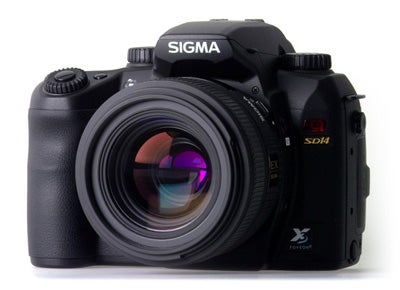The 14-megapixel SD14 is the third DSLR from Sigma to employ the unique triple-layered Foveon sensor. Has the company got it right this time?
Sigma SD14 Review
Features
Out on a Limb
Like Sigma’s previous DSLR excursions the SD14 includes two technologies that are unique to the manufacturer – the first being the lens mount and the other the sensor. In terms of the lens mount it’s not that surprising that the Sigma SD14 uses Sigma’s own SA lens mount. This gives the photographer the pick of Sigma’s lens line-up, with a 1.7x focal length magnification resulting from the size of the SD14’s sensor.
In this instance the imaging chip in question is a Foveon X3 CMOS measuring 20.7×13.8mm. Due to the unique structure of the Foveon sensor, Raw files are output at a 2640×1760 pixel resolution (4.64MP total), although Sigma claims this is the equivalent of a 14MP image due to the triple-layer construction.
JPEG Capture
Unlike previous Sigma DSLRs there is now the option to record JPEG files, with four size options on offer. At the top end of the range is ‘super high’, which delivers a 4608×3072 pixel image (14.15MP), with a ‘high’ option below it delivering images matching the Raw 4.64MP file size noted above. It’s a shame Raw and JPEG files can’t be recorded simultaneously though. ‘Flat out’ the SD14 can shoot JPEG images at a rate of three frames per second, although this will only be maintained across six ‘high’ quality JPEGs. If you need a greater burst depth then reducing the image size to ‘medium’ (2.1MP) will deliver 12 consecutive frames, while 24 shots can be taken using the ‘low’ (1.03MP) JPEG setting.
AF System
Aside from the SD14’s new-found ability to record JPEG files a further evolutionary step comes with the inclusion of a 5-point AF system. This might not sound like much, but considering the SD9 and SD10 had only a single AF point it should certainly help with focusing on off-centre subjects.
Exposure Modes
Yet ultimately the SD14’s feature list is a rather spartan affair, with functionality rather than unnecessary gimmicks being the order of the day. The shooting modes encompass the Program, Aperture Priority, Shutter Priority and Manual quartet to provide as much control over your image making as you might require, while eight-segment evaluative, centreweighted average and centre metering (large spot) patterns cover the exposure-making decisions.
Sensitivity and White Balance
In order to ensure you can get a sensitivity to suit the lighting conditions the ISO runs from 100 to 1600 equivalents in full steps, and although there isn’t an ‘extended’ ISO 3200 setting the given range is all that most people will need. The white balance system is equally utilitarian compared to some cameras, with an automatic WB setting joined by six presets and a custom option that allows you to set your own neutral tone using a white or grey card. The appearance of your image can be further adjusted with changes to the saturation and contrast (±1 in 1/10 steps) and with the choice of AdobeRGB and sRGB colour spaces depending on whether you want to go straight to print or fine-tune the results first.
Other Features
Other useful inclusions – especially for flash users – are a built-in flash with a guide number of 11 (GN11m@ISO100), a hotshoe that delivers TTL flash control over compatible (that is, Sigma) flash guns and a flash sync socket on the side if you want to use a manual flash unit or studio lighting.





